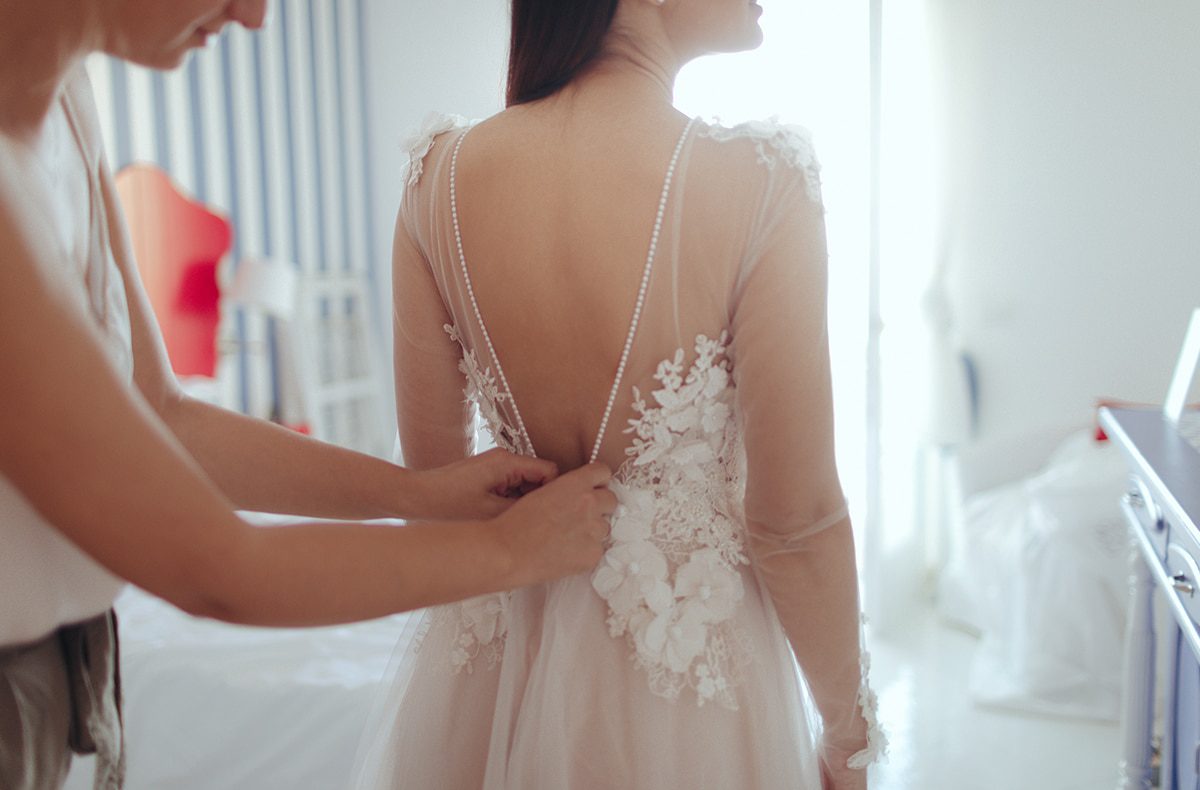
A month and some change ago, I shared my story of venturing to the hallowed halls of Kleinfeld Bridal, where I found myself saying “yes to distress” when I fell in love with a gown that would need to be rush ordered from Italy and was well over my planned dress budget of “as little money as humanly possible.”
In the weeks that followed, my dress search continued, but as I weighed my other options, I just couldn’t get that damn gown out of my head. It was magical. It was lovely. It was designed to look beautiful by the ocean at sunset — a perfect match for our beachside Puerto Rican venue. It was the dress. (And mind you, I didn’t even think I was the kind of bride who had a “the dress” out there. I was supposed to be the chill kind who is like, “whatever.” Damn you, gorgeous handcrafted Italian fantasy gown!)
The dress distress continued and intensified as I discovered the designer would be closed for all of August (Italians, what can you do?) and that new orders wouldn’t be available until December. I am getting married on October 29. So… no bueno. Even if I had the six thousand dollars to spare — which I frankly do not: file under “inflation” and “this economy” and “paying for a wedding” — I wouldn’t have been able to get the dress in time.
That left me with one final option to still get the dress: getting it “preloved.”
Wedding gown resale is a relatively young practice that has been largely enabled by the internet in the recent past. Secondhand shopping has gotten a luxury update in recent years — while high-end thrift shops like Wasteland are not new, the internet has allowed a much wider reach than your local Goodwill, with better quality control. There are myriad options out there, from The Real Real, which authenticates their resale products, to platforms like Poshmark, where sellers ship directly to buyers from home, allowing them to clear out their closet and make a few bucks in the process. Sites like Still White, Nearly Newlywed, and the more directly named PreownedWeddingDress.com have emerged to take advantage of the massive (and very specific) market of bridal fashion. These are gradually becoming a more popular option as more and more brides are growing eco-conscious — as well they should. Apparently, “the average wedding produces 400lbs (200kg) of garbage and 63 tons of CO2,” so finding any way to make a dent in that footprint is a good thing.
Wedding dresses are the perfect candidate for resale, as an incredibly high ticket garment that is worn literally once, and is therefore unlikely to see too much wear-and-tear. Although the alterations do present a possible challenge — each bride hems and adjusts dresses to her specific height and size, of course — there’s really no reason why every bride should need to buy a dress brand new. In fact, it’s sort of absurd that we do this so often.
And yet we do, because even though it is slowly starting to be more socially acceptable to buy a pre-owned wedding dress, it’s far from normalized. That’s because a whole slew of strong feelings and judgment have been embedded into the capitalist dress-finding ritual, as comprehensively as the hand-embroidered details on my future wedding gown. The very phrase “second-hand” has a sort of sad, negative connotation to it, as if you are not worthy of your own “firsthand” dress. “You deserve this: it’s your day,” the bridal industrial complex tells us.
It also goes against the current bride: one friend who decided to resell her dress said she got a whole lot of side-eye from people who thought it was “weird” and that it meant she “didn’t have faith in her marriage.” Because that makes sense.
Given that I’d never been a believer in “the dress,” it was pretty easy for me to get over any momentary feelings of weirdness at the thought of wearing a pre-owned garment for my wedding. In fact, once I started looking into it, I actually came to prefer the idea of getting a “preloved” dress to a new one. Naturally, I’m glad I went to Kleinfeld so I could find the dress in the first place, but there is no reason once I knew what I wanted that I had to have it created from scratch. The idea that it’s “mine” and unique is fiction: it’s a design from a bridal brand. Other people have tried this dress on at Kleinfeld and had the same exact feeling I did — literally. The three women I found reselling their gowns had all bought them from Kleinfeld. And it extends even further than that: in fact, the gown I fell in love with was actually the brand’s best-seller from their 2019 collection — which has inspired my friend who works in bridal to tease me endlessly as “basic.”
While the bridal industry would prefer us consumers to hold onto that feeling of “it must be uniquely mine and therefore I need to buy my own dress,” I found that both myself and the potential sellers I reached out to bonded over the fact that we were, in fact, not unique in finding this dress to be absolutely gorgeous and perfect. We gushed about its delicacy, its arresting color, and the way it made us feel like we were floating through a fairytale when we put it on. We all also shared the same experience of not wanting to spend a ton of money at Kleinfeld and finding that we simply could not resist the gown’s siren call.
I sent pictures of me in the dressing room, while they sent oodles of photos from their happy day, reflecting on how much joy it brought them to wear the gown and how much they hoped it would fit me so I could have the same feeling. One had been married in Morocco, the other in Albania, but all of our weddings were beach-side. Both brides became emotional at the happy memory, but expressed only a warm, generous hope that I could feel the same joy — and it certainly didn’t hurt that they’d be getting a few thousand dollars out of the exchange, too.
The actual process of figuring out the sale and exchange was complex. We all had the fortune of living close enough to each other that I could meet them to try the gowns on — only most reselling platforms try to make it impossible for buyers and sellers to contact one another directly, so that they don’t get cut out of the profits. While one bride was able to slyly offer her Instagram on one less fascist platform, the other bride had to resort to some internet sleuthing, somehow finding my social media through Google and messaging me her phone number through her friend’s Instagram, as she’d deleted her account.
This resourceful former bride happened to be my exact height — 5’7” — and while she was significantly better endowed than myself, she hadn’t altered the dress except for a small “modesty patch” and the bottom of the neckline’s deep v, but was selling what translated to a size 6, which was a little smaller than what I’d been looking for. The other bride was a touch shorter than me at 5’5,” but had worn tall heels, so the hem might work. She was also more busty than me, so she’d added a few more floral appliques that she’d purchased directly from the brand to “conceal side boob” that could be easily removed if desired. She was selling a size 10, which was a little larger. Between the two, it seemed like one of them would work.
My 5’7” new best friend lived in New Jersey and worked in Midtown, and in yet another impressively resourceful moment, she suggested we meet up at Bloomingdale’s in the second floor bathroom, which conveniently has a whole anteroom of tall mirrors. I felt nervous and excited, anxious that it might not fit, eager to find out. It felt like a cross between a first date and a drug deal, since we were getting around the resale platform fees and I was potentially about to hand over thousands of dollars. I can’t imagine an illicit exchange more “white woman” than reselling a designer Italian wedding dress in a Bloomingdale’s bathroom.
After getting through a nightmare of tunnel traffic, my seller appeared, bag in hand, excited to get down to business, since she was already running late to work. She showed me a few spots she’d had mended from where her heel had pierced the fabric on a very obscure spot of fabric, provided her receipts from Kleinfeld, pointed out how the modesty patch was affixed and showed me the bag of extra fabric, in case I needed to alter it in any way.
I tried it on, and while a little snug, it did zip up completely, was absolutely the right length, and it was the dress. The former bride marveled that it fit like a dream — something I still cannot fathom, since she wears a DD cup, while my barely Bs let me rock a deep v with a whole lot of what my bridal industry friend calls “tasteful sternum.” It really was like The Sisterhood of the Traveling Pants, only a dress: it somehow fit our different bodies equally well, and made us feel equally beautiful.
I FaceTimed my aforementioned bridal industry friend to confirm the dress wasn’t too snug and generally was the right fit, and after checking the shoulders, waist, and length, he agreed: we’d found it. He thought it was in pristine condition and commented that I might not even have to do any alterations — which would save me even more money, in the end.
While I did have another potential seller ready for me to pop over to Hudson Yards and try on her gown if I wanted, I did feel the pressure not to let this one slip away — after all, I wasn’t so sure the hem on the other would work. So after a very weak attempt at haggling — she’d already had someone offer her three grand, so I caved pretty immediately — I bit the bullet and transferred over a hefty chunk of my bank account and left Bloomingdale’s a little broker and a whole lot more bridal than I’d entered.
So that’s how I went from distressed to dressed in one wild weekend, and how I’ve made a new friend in the process. (My seller insists I must keep her posted on the shoes I choose, how I do my hair, and send her all the pictures from the day, and has given me a standing invite to visit her where she tends bar.)
So if you’re a bride and your gown is taking up space in a closet, I’d encourage you to consider reselling — and if you’re about to get married and are thinking of doing a “trash the dress” photoshoot, please don’t. The only thing I can imagine that’s more offensively wasteful than wearing a dress once is intentionally destroying a perfectly good dress after wearing it once.
Wedding dress resale is not only economically and ecologically a strong choice, it’s also a pretty beautiful and direct way of supporting other women. The friend I mentioned who was accused of “not having faith in her marriage” sold her dress to a first-year teacher who could never otherwise afford it on her salary. My friend’s mother who bought the dress is a retired teacher, so she said “it just felt right.” The teacher got the dress of her dreams, and my friend already had all the memories of her moment with it, too. (In another Sisterhood moment, she mentioned that her alterations randomly fit this woman perfectly, too!)
Ultimately, the wedding isn’t about the dress, the ring, or the venue: it’s about the story and the memories we make. It’s the story of starting a new life together as a couple, of gathering family and friends together and celebrating love. I can’t imagine a better story for my wedding dress than the one I just told — it makes the gown feel even more special since I’ve shared it with someone else. Who knows: perhaps in a few months, I’ll resell it, too, and the Sisterhood of the Traveling Wedding Gown will have yet another member. I’ll be sure to write about it if I do.


